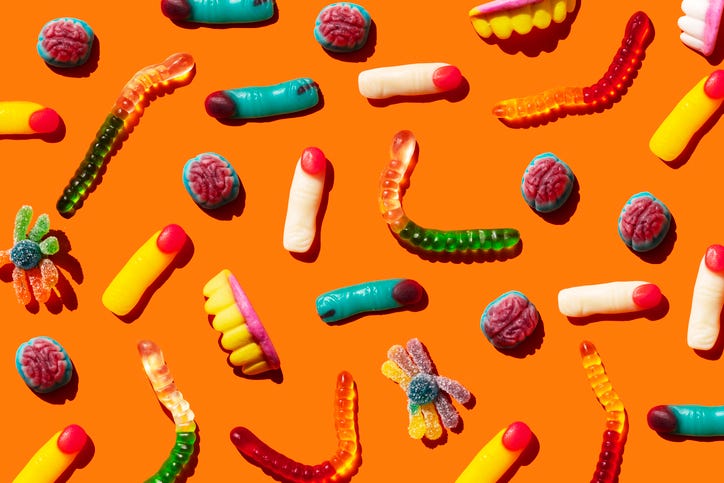In the spirit of Halloween, we interviewed three notable writers in the field of snacks and food culture: Doug Mack of Snack Stack, Megan Seling of Snack and Destroy, and Katherine Spiers of Smart Mouth.
These interviews have been lightly edited for length and clarity.
What’s your Substack about in one sentence?
Doug Mack: Snack Stack is a bite-sized newsletter that explores the origins and cultural significance of snacks around the world.
Megan Seling: Snack and Destroy is all about snacks, candy, and rock and roll!
Katherine Spiers: Smart Mouth is about how the food you eat got in front of your face.
What do you hope your readers get out of your publication?
Megan: I’ve been a culture writer for more than 20 years, and I’ve covered everything from politics to hockey. When the pandemic hit and every day felt like a joyless slog, food and music were the only things I felt like I could get amped about. And I wasn’t just interested in food and music itself but the people behind them.
I hope Snack and Destroy readers discover new favorite candies and snacks, but I also want the newsletter to be somewhere people can go to talk about why they love the things they love—in this case, songs and snacks—and share those things with people in their own lives. Really, I just want it to be a fun place to wholeheartedly, earnestly enjoy things.
Katherine: A few years after becoming a food writer I realized that I personally was more interested in where dishes came from than what they tasted like. I hope readers just enjoy reading these brief food history dispatches; in a bigger sense I hope it encourages people to reconsider “authentic” and how we conceive of migration, back to ancient times.
Read Katherine’s post about the invention of the chocolate chip cookie here.
Doug: I’m a travel writer who hasn’t been able to travel much lately (young kids, pandemic, etc.), and I’ve been missing seeing and learning about places and cultures that are unfamiliar to me. At the same time, I love applying a sense of curiosity and exploration to my own everyday surroundings and the things I take for granted. So I wanted to do all of that while maintaining some sense of focus, and snacks seemed like a good topic. A big part of their appeal is that we don’t have to think much about them—we typically snack on what’s readily available, easy to eat, and offers familiar, comforting flavors. But those very traits mean they’re often highly specific to places and cultures and periods in history.
I want Snack Stack to give readers both a feeling of learning about a particular place or moment in time and an understanding of how these foods relate to much larger issues. For example: pistachios are connected to tumultuous international relations; caramel apples demonstrate larger trends in American culture around 1900; Warheads tell us about the science of disgust.
What Halloween treat has the weirdest or most fascinating backstory?
Katherine: I don't think I can pick just one weirdest, but I do have something to say about candy corn. (Which was invented in the late 1800s as part of a common theme for candy at the time: butter creams in the shape of vegetables.) The conceit behind candy corn's advertising in the 1920s was, "Haha, only chickens eat corn, our mascot is a rooster." Now, obviously, corn was and is a very common food. But at the time, wealthier white people believed it to be tacky. Or told themselves they believed it was tacky so they could feel superior about something. This sounds ridiculous to us now, but the thing is, we still do it! Think about the phrase "cheap eats." What story are we telling ourselves with that? All that to say, candy corn is educational.
Doug: I recently wrote about gummi worms and their cultural legacy, which turns out to be wild and complicated. Gummies as we know them weren’t really a thing in the U.S. until the 1980s, but they’d been popular in Europe in various animal forms since the 1920s. In 1981, two separate companies start selling them in the U.S. A third candy manufacturer, Trolli, decides to do something entirely different (not cute or loveable), which leads them to worms.
The marketing strategy is built on a sense of low-risk disgust: “They look gross but they taste great!” The worms are an instant hit, paving the way for products like gummi rats as well as other seemingly off-putting treats like the super-sour candy trend of the early 1990s. In the 2000s, candy companies keep pushing the boundaries of what’s considered good taste, culminating in things like gummi roadkill and Haribo gummies called—not a joke—Ass With Ears, which must be seen to be believed. Basically, if you’ve ever seen a packaged candy that’s trying to gross you out, its existence is the direct result of gummi worms and their success in the 1980s.
Read Doug’s post about the history of gummi worms here.
What songs would you pair with classic trick-or-treating candy, and why?
Megan: This is such a good question, but so hard to answer! My immediate answer is “Monster Mash” by Bobby “Boris” Pickett because I really do love that song and I listen to it every October. It reminds me of my childhood, of Halloween parties and getting ready for trick-or-treating with friends.
I’d also have to go with “Gimmie Gimmie Gimmie” by Black Flag. It’s an anti-consumerism punk rock song, but Halloween is all about flipping shit on its head and getting weird, right? I like to imagine a mosh pit of little ghouls and goblins forming in someone’s front yard, with candy and fake blood flying everywhere, while Henry Rollins cries out, “Gimme, gimme, gimme, I need some more! Gimme, gimme, gimme, don’t ask what for!”
Also: “Tootsee Roll” by 69 Boyz, “I Wanna Eat Chocobars” by Shonen Knife, and Cibo Matto’s cover of “The Candy Man.”
Read Megan’s post about this year’s new Halloween candy here.
What’s the worst Halloween candy, and why?
Doug: I loathe the little round chalky candies like SweeTarts and Necco Wafers. The flavors are terrible—they don’t register as “sweet” or “sour” or much of anything—and the texture is somehow even more off-putting, dry but not crunchy in any pleasant kind of way. They feel like crafting materials that have been mislabeled as food.
Megan: Jolly Ranchers. I hate Jolly Ranchers. The candies, the sticks, the lollipops—they’re all terrible. The flavors are bad, and the candy is like a weapon in your mouth! It’s filled with tiny air pockets that are just big enough for a tastebud or two to slip in and get caught on one of the sharp edges. Ouch! And they’re supposed to be a hard candy, but because they’re made with so much corn syrup, you can’t actually crunch on them? If you try, it just melts onto your molars, and then you’re stuck with a wad of sugar shrapnel in your mouth! What a stupid candy.
Katherine: Gum. It’s really missing the point.
Who’s another Substack writer you’d recommend?
Megan: I really love Lindy West’s newish newsletter, Butt News. A lot of people know Lindy from her book Shrill, but she’s also a brilliant and hilarious film critic. She released a collection of her film writing last year, a book called Shit, Actually, and Butt News is an expansion on that. Every week she reviews a movie that readers have recommended—it’s generally a terrible one—and reviews it in a way only she can. It’s super-funny, and I’ve had fun rewatching some of the movies after she has featured them in the newsletter.
Katherine: Casey Johnston of She’s A Beast. Even though I write about food, I very purposefully avoid any discussions of health. But that doesn't mean I'm not interested in it! Casey offers interesting information about exercise and has a point of view wildly different from that of the average “fitness influencer.” She's also funny.
Doug: Mike Sowden’s newsletter, Everything Is Amazing, is such a joy. He’s another travel writer who writes about shifting your perspective on the world around you, and his emails are just brimming with curiosity and a sense of adventure. He had a recent one on mirages and the way that nature tricks your eye and messes with your head, and it stuck with me for days.
For more writing on snacks and food history, subscribe to Doug Mack’s Snack Stack; Megan Seling’s Snack and Destroy, and Katherine Spiers’s Smart Mouth.





Share this post